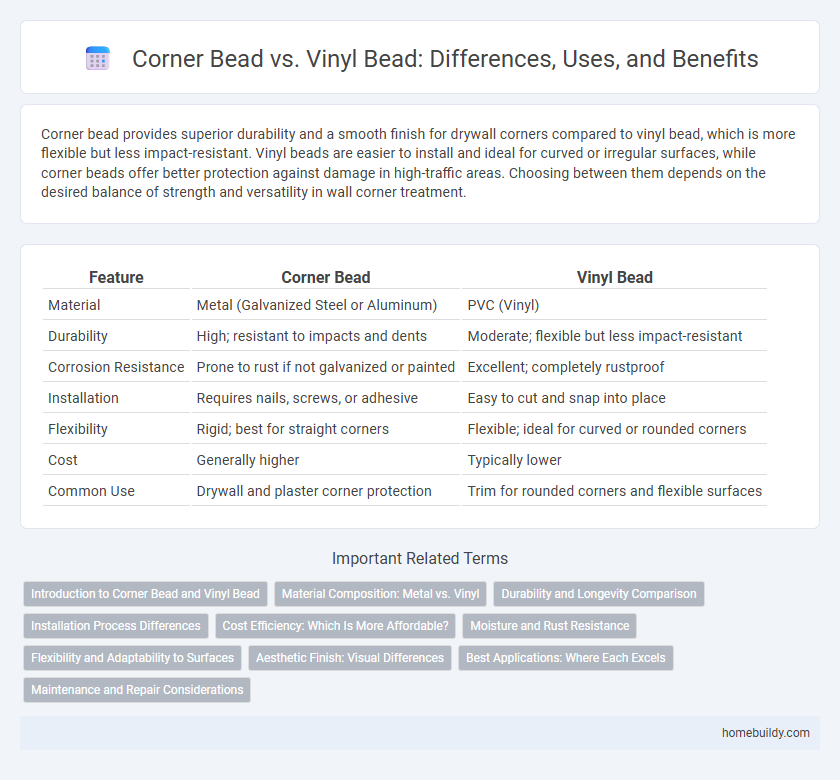Corner bead provides superior durability and a smooth finish for drywall corners compared to vinyl bead, which is more flexible but less impact-resistant. Vinyl beads are easier to install and ideal for curved or irregular surfaces, while corner beads offer better protection against damage in high-traffic areas. Choosing between them depends on the desired balance of strength and versatility in wall corner treatment.
Table of Comparison
| Feature | Corner Bead | Vinyl Bead |
|---|---|---|
| Material | Metal (Galvanized Steel or Aluminum) | PVC (Vinyl) |
| Durability | High; resistant to impacts and dents | Moderate; flexible but less impact-resistant |
| Corrosion Resistance | Prone to rust if not galvanized or painted | Excellent; completely rustproof |
| Installation | Requires nails, screws, or adhesive | Easy to cut and snap into place |
| Flexibility | Rigid; best for straight corners | Flexible; ideal for curved or rounded corners |
| Cost | Generally higher | Typically lower |
| Common Use | Drywall and plaster corner protection | Trim for rounded corners and flexible surfaces |
Introduction to Corner Bead and Vinyl Bead
Corner bead and vinyl bead serve as essential drywall finishing components designed to reinforce and protect wall corners. Corner bead, typically made from metal such as galvanized steel or aluminum, offers superior durability and impact resistance, ensuring long-lasting edge protection. Vinyl bead, crafted from flexible PVC, provides a lightweight, rust-proof alternative ideal for moisture-prone areas and easy installation.
Material Composition: Metal vs. Vinyl
Corner bead is typically made from galvanized steel or aluminum, offering superior strength and durability for protecting drywall corners against impacts and wear. Vinyl bead, composed of flexible PVC material, provides resistance to moisture and corrosion but lacks the rigidity of metal, making it better suited for areas prone to humidity rather than heavy impacts. Choosing between metal and vinyl corner beads depends on the specific needs of the project, with metal preferred for structural protection and vinyl favored for moisture resistance.
Durability and Longevity Comparison
Corner bead made from galvanized steel offers superior durability compared to vinyl bead, resisting dents, cracks, and wear over time. Vinyl bead is more flexible and resistant to moisture but tends to degrade faster under heavy impact or UV exposure. Steel corner bead maintains structural integrity for decades, making it ideal for high-traffic or high-stress areas.
Installation Process Differences
Corner bead installation typically involves nailing or screwing metal strips along drywall edges, requiring precise alignment and spot fastening for durability. Vinyl bead installation uses adhesive backing or wet drywall compound for attachment, offering a more flexible and easier-to-handle process that accommodates curved surfaces better. The metal corner bead demands more tools and skill, while vinyl bead provides faster application and easier adjustments during the finishing process.
Cost Efficiency: Which Is More Affordable?
Corner bead generally offers greater cost efficiency compared to vinyl bead due to its durable metal construction and longer lifespan, reducing the need for frequent repairs or replacements. Vinyl bead tends to be less expensive upfront but may incur higher long-term costs because of its susceptibility to cracking and damage. For budget-conscious projects seeking durability and minimal maintenance, corner bead proves to be the more affordable choice over time.
Moisture and Rust Resistance
Corner bead made from galvanized steel offers strong rust resistance but may still be susceptible to moisture over time, leading to potential corrosion in high-humidity environments. Vinyl bead provides superior moisture resistance since it is non-metallic and completely impervious to rust, making it ideal for areas prone to dampness or water exposure. Choosing vinyl bead enhances durability and longevity in wet conditions, while metal corner bead may require protective coatings to prevent rust damage.
Flexibility and Adaptability to Surfaces
Corner bead offers superior flexibility compared to vinyl bead, making it ideal for curved or irregular surfaces where precise fitting is essential. Its adaptability allows for smooth application on both interior and exterior corners, ensuring a seamless finish without cracking or popping. Vinyl bead, while durable, tends to be more rigid and less forgiving on uneven surfaces, limiting its use in complex architectural designs.
Aesthetic Finish: Visual Differences
Corner bead offers a crisp, clean edge that enhances wall corners with a smooth, professional finish, while vinyl bead provides a softer, more flexible appearance suitable for curved or irregular surfaces. The metallic sheen of traditional corner beads contributes to a sleek and polished look, whereas vinyl bead's matte texture results in a less reflective, subtler aesthetic. Selecting between corner bead and vinyl bead influences the overall visual impact, with metal beads emphasizing sharpness and durability, and vinyl beads providing a more blended, understated finish.
Best Applications: Where Each Excels
Corner bead offers superior durability and impact resistance, making it ideal for high-traffic areas requiring strong edge protection, such as commercial buildings and busy hallways. Vinyl bead excels in moisture-prone environments due to its flexibility and water resistance, making it the preferred choice for bathrooms and exterior corners. Selecting between corner bead and vinyl bead depends heavily on the specific demands of the application site and environmental exposure.
Maintenance and Repair Considerations
Corner bead typically requires simple maintenance due to its rigid metal or plastic structure, which resists cracking and chipping. Vinyl bead offers flexibility, reducing damage in high-impact areas but may require more frequent inspection for tears or warping. Repairing metal corner bead often involves patching or replacing sections, while vinyl bead repairs are usually limited to minor adhesive fixes or replacement of damaged strips.
corner bead vs vinyl bead Infographic

 homebuildy.com
homebuildy.com